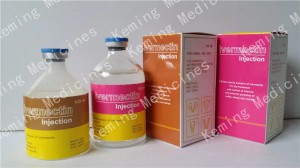Pharmacological Effect
Pharmacodynamics
Ivermectin mainly has a good killing effect on nematodes in the body and arthropods on the body surface. Its deworming mechanism is to promote the release of γ-aminobutyric acid (GABA) from presynaptic neurons, thereby opening GABA-mediated chloride ion channels. Ivermectin also has selectivity and high affinity for glutamate-mediated chloride ion channels located near the GABA-mediated site in invertebrate nerve and muscle cells, thereby interfering with neuromuscular signal transmission and relaxing the worm body Paralysis, resulting in the death or expulsion of the parasite. Inhibitory interneurons and excitatory motor neurons in nematodes are its sites of action, while in arthropods it is the neuromuscular junction. Haemonchus, Osteria, Cooperia, Trichostrongylus (including Trichostrongylus einrichi), Rounded Nematode, Upostostomum, Leptostomum, Trichocephala, Esophagostomum, The repelling rate of Dictyocaulus and the adult and fourth-stage larvae of Dictyocaulus and Sheep Chabertale is 97%~100%. It is also very effective against arthropods, such as fly maggots, mites and lice. It is slightly less effective against chewing lice and sheep ticks. Ivermectin is also very effective against ticks and flies breeding in feces. Although the drug cannot kill ticks immediately, it can affect feeding, molting and egg laying, thereby reducing reproductive ability. The effect on blood flies is similar. The rate of repelling roundworms, strongyloides red, strongyloids lamblia, trichocephala, esophageal mouth nematodes, strongyloides, and immature worms of crown worms in pigs is 94%~100%. Intraductal Trichinella (not effective for intramuscular Trichinella) is also very effective and also gives good control of blood lice and Sarcoptes suis. Not effective against flukes and tapeworms.

Pharmacokinetics
The pharmacokinetics of ivermectin varies significantly with different animal species, dosage forms and routes of administration. The bioavailability of subcutaneous injection is higher than that of oral administration, but the absorption of oral administration is faster than that of subcutaneous injection. After absorption, it can be well distributed to most tissues, but it is difficult to enter the cerebrospinal fluid. The apparent volumes of distribution of cattle, sheep and pigs are 0.45~2.4, 4.6 and 4L/kg, respectively. In most animals there is a longer half-life, cattle, sheep and pigs were 2~3, 2~7 and 0.5 days. This product is metabolized in the liver, mainly undergoes hydroxylation in cattle and sheep, and mainly undergoes methylation in pigs. It is mainly excreted from feces, and less than 5% is excreted from urine as the original form or metabolites. Up to 5% of the administered dose is excreted in milk in lactating dams.
Medicine Interactions
Concomitant use with diethylcarbamate may result in severe or fatal encephalopathy.
Function and use
Macrolide antiparasitic drugs. It is used to control livestock nematode disease, mite disease and other parasitic insect diseases.
Post time: Jan-03-2023




